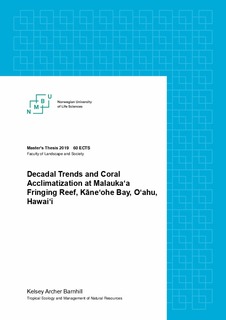| dc.contributor.advisor | Bryceson, Ian | |
| dc.contributor.advisor | Bahr, Keisha | |
| dc.contributor.author | Barnhill, Kelsey Archer | |
| dc.coverage.spatial | USA, Hawaii | nb_NO |
| dc.date.accessioned | 2019-06-06T11:10:21Z | |
| dc.date.available | 2019-06-06T11:10:21Z | |
| dc.date.issued | 2019 | |
| dc.identifier.uri | http://hdl.handle.net/11250/2600134 | |
| dc.description.abstract | Globally, coral reefs are under threat from climate change and increasingly frequent bleaching events. However, corals in Kāneʻohe Bay have repeatedly shown resilience and the ability to acclimatize to rising temperatures and increased frequencies of bleaching events. The Malaukaʻa fringing reef -first surveyed in 2000- is revisited to compare species composition and percent cover of corals, algae, and mixed sand to investigate how the reef has fared over 18 years. Despite climate change-induced temperature increases and two major bleaching events, the fringing reef saw no significant change in total coral cover percent, nor a change in percent cover of the two dominant reef-building corals: Montipora capitata and Porites compressa. However, the loss of two coral species and addition of one new coral species between surveys indicates that while the fringing reef remains intact, a shift in species composition has occurred. While locally rare species from the 2000 study were not found in 2018, the reef remains. The survival of the fringing reef studied indicates resilience and suggests these Hawaiian corals are capable of acclimatization to climate change and bleaching events. A reciprocal transplant experiment was also conducted to determine if calcification (linear extension and accretion) for M. capitata and P. compressa varied between two sites 600 meters apart at either end of the surveyed reef and whether or not genetics or environmental factors were responsible for the differences. Linear extension did not vary between sites for either species, however accretion (measured as change in mg g -1 d -1) was significantly different between sites for P. compressa. Differences in accretion following transplantation suggest both environment and genetics impacted calcification of P. compressa in Kāneʻohe Bay. | nb_NO |
| dc.language.iso | eng | nb_NO |
| dc.publisher | Norwegian University of Life Sciences, Ås | nb_NO |
| dc.rights | Attribution-NonCommercial-NoDerivatives 4.0 Internasjonal | * |
| dc.rights.uri | http://creativecommons.org/licenses/by-nc-nd/4.0/deed.no | * |
| dc.subject | Acclimatization | nb_NO |
| dc.subject | Calcification | nb_NO |
| dc.subject | Coral Reefs | nb_NO |
| dc.subject | Reciprocal Transplant | nb_NO |
| dc.subject | Resilience | nb_NO |
| dc.subject | Macroalgae | nb_NO |
| dc.subject | Species Composition | nb_NO |
| dc.title | Decadal trends and coral acclimatization at Malaukaʻa Fringing Reef, Kāneʻohe Bay, Oʻahu, Hawaiʻi | nb_NO |
| dc.type | Master thesis | nb_NO |
| dc.subject.nsi | VDP::Mathematics and natural science: 400 | nb_NO |
| dc.description.localcode | M-ECOL | nb_NO |

